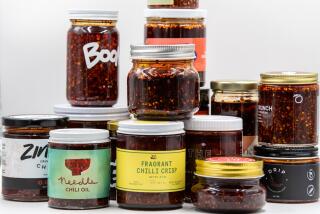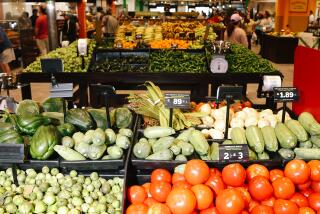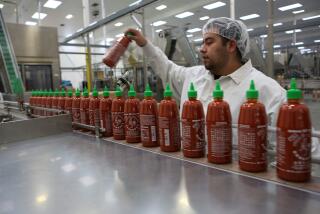For those who like it hot, really, really, hot
CHANGPOOL, INDIA -- — The farmer, a quiet man with an easy smile, has spent a lifetime eating a chile pepper with a strange nickname and a vicious bite. His mother stirred them into sauces. His wife puts them out raw: blood-red morsels of pain to be nibbled carefully, very carefully, with whatever she’s serving for dinner.
Around here, in the hills of northeastern India, it’s called bhut jolokia -- the “ghost chile.” Anyone who has tried it, they say, could end up an apparition.
“It is so hot, you can’t even imagine,” said the farmer, Digonta Saikia, working in his fields in the midday sun, his face nearly invisible behind an huge straw hat. “When you eat it, it’s like dying.”
A few months ago, Guinness World Records made it official, the bhut jolokia is the hottest chile in the world.
Outsiders, Digonta insisted, shouldn’t even try it. “If you eat one,” he told a visitor, “you will not be able to leave this place.” The smallest morsels can flavor a sauce so intensely it’s barely edible. Eating just a raw sliver causes watering eyes and a runny nose. An entire chile is an all-out assault on the senses.
For generations, though, it’s been loved in India’s northeast, eaten as a spice, a cure for stomach troubles and, seemingly paradoxically, a way to fight the crippling summer heat.
Now, with the bhut jolokia in the record books -- it has more than 1,000,000 Scoville units, the scientific measurement of a chile’s spiciness -- northeast India plans to taking its chile to the outside world.
Exporters are eagerly courting rabid chile-lovers, a worldwide community that for years has traded stories about a mysterious, powerful Indian chile. Farmers are planting new fields of the chiles, officials are talking about development programs.
Chances are no one will get rich. But in a region facing bloody insurgencies, widespread poverty and a decline in a key industry, tea, the world record status has meant a lot of pride -- and a little more business.
“It has got tremendous potential,” says Leena Saikia, the managing director of Frontal AgriTech, in the state of Assam, which has been in the forefront of bhut jolokia exports.
Last year, her company shipped out a ton of the chiles. This year, with the surge in publicity, the goal is 10 tons to nearly a dozen countries. “We’re getting so many inquiries,” says Saikia, who is unrelated to the farmer. “We’ll be giving employment to so many people.”
For now, at least, transport issues and a tangle of regulations mean most exports are of dried chiles and chile paste. But, Saikia added, the paste can be used for everything from hot sauces to tear gas. Because of its strength, manufacturers can use far less bhut jolokia than they would normal chiles.
India’s northeast, a cluster of seven states on the country’s eastern edge, is a place where most people appear ethnically closer to China and Myanmar. It’s a deeply troubled area, often neglected by New Delhi, where more than two dozen ethnic secessionist groups are fighting the central government and one another. Many areas remain off-limits to foreigners and few days pass without at least one killing.
In Assam, the wealthiest of the region’s states, the long-dominant tea industry is suffering from falling prices and rising costs, and one-third of the population lives below the poverty line. Attacks by the United Liberation Front of Asom, and government crackdowns have brutalized the region.
“Maybe this bhut jolokia can help change things here,” says Ranjana Bhuyan, a high school teacher shopping for vegetables in the Assamese town of Jorhat on a recent evening. Like most people here, she mixes bhut jolokias into sauces, or pickles them as a spicy relish, but also likes to eat tiny pieces raw, enjoying the flavor and the sharp jolt.
“People have been eating this forever,” she says.
Only in the last few years, though, has its fame spread. The first reports filtered out in 2000, when the government’s Defense Research Laboratory in Assam announced the bhut jolokia as the world’s hottest chile. But their tests, reportedly done during research on tear gas, took years to be corroborated.
The confirmation came earlier this year from New Mexico State University’s Chile Pepper Institute, where heat is a religion. It got its first bhut jolokia seeds in 2001, but it took years to grow enough peppers for testing.
A chile’s spiciness can be scientifically measured by calculating capsaicin content, the chemical that gives a pepper its bite, and counting its Scoville units. As a way of comparison: Classic Tabasco sauce ranges from 2,500 to 5,000 Scoville units. A jalapeno pepper measures anywhere from 2,500 to 8,000. The previous record holder, the Red Savina habanero, was tested at up to 580,000 Scovilles.
The bhut jolokia crushed those contenders, testing at 1,001,304 Scoville units.
Small amounts of bhut jolokia are grown elsewhere, including Sri Lanka and Bangladesh. But horticulturists say the gentle sloping hills, heat and humidity of India’s northeast make it the ideal greenhouse.
Still, getting your hands on a fresh bhut jolokia is difficult except in a handful of towns here. A few specialty companies in the United States and Britain sell dried chiles and seeds, but the plants are painfully fragile and very difficult to grow, susceptible to many pests and diseases.
So it may take awhile before farmers outside this region are able to grow the small, wrinkled pepper on a large scale.
More to Read
Sign up for Essential California
The most important California stories and recommendations in your inbox every morning.
You may occasionally receive promotional content from the Los Angeles Times.










